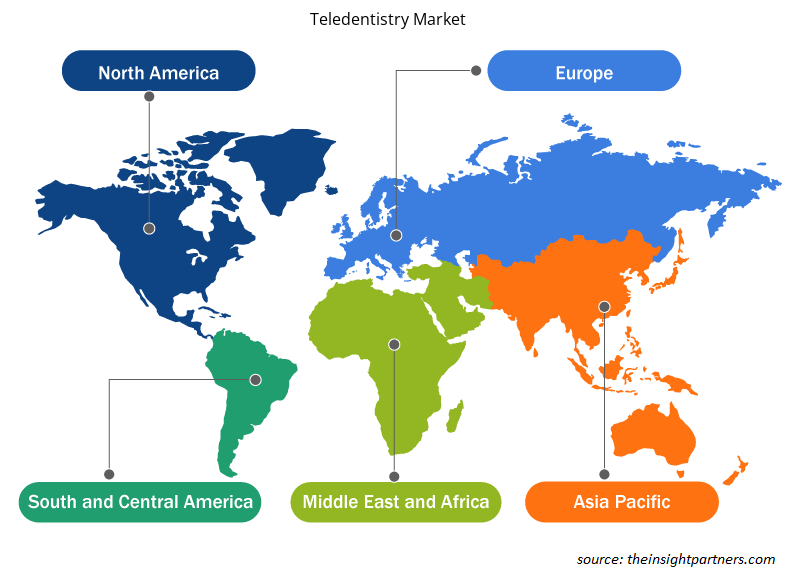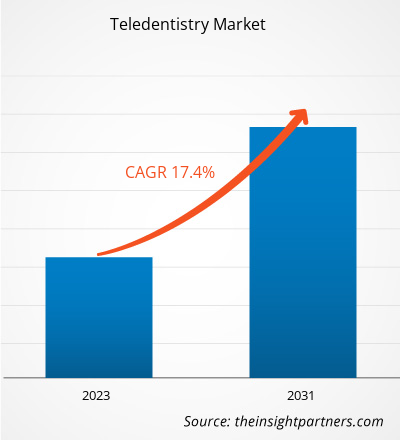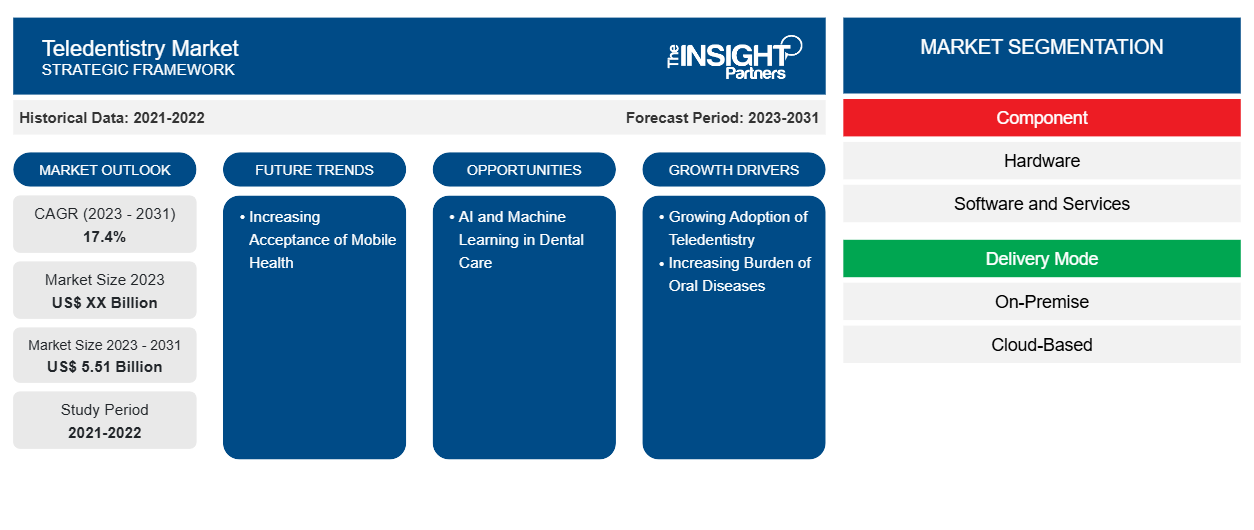En 2021, le marché de la télémédecine représentait 1,04 milliard USD et devrait atteindre 5,51 milliards USD d'ici 2031, contre XX milliards USD en 2023. Le marché devrait enregistrer un TCAC de 17,4 % en 2023-2031. L'acceptation croissante de la santé mobile devrait rester l'une des principales tendances du marché de la télémédecine.
Analyse du marché de la télémédecine
La croissance du marché mondial de la télémédecine est le résultat direct des avantages qu'il apporte au secteur dentaire, tels que la popularité croissante des solutions de santé numériques , les avancées en matière de technologie de communication et d'imagerie, et la commodité qu'il offre aux professionnels dentaires et aux patients. Les principaux acteurs du marché investissent dans des activités stratégiques, notamment des acquisitions, des fusions, des collaborations et des lancements de logiciels, pour conserver un avantage concurrentiel, ce qui se traduit par une croissance du marché.
Aperçu du marché de la télémédecine
La télémédecine dentaire rend les soins bucco-dentaires plus accessibles, en particulier dans les pays en développement et en cas d'urgence. La télémédecine dentaire, grâce à l'utilisation des technologies de télécommunication, permet un accès mondial aux patients et aux dentistes en éliminant les barrières régionales. La croissance de la population âgée, ainsi que son acceptation accrue des technologies de télémédecine dentaire en raison de leur commodité et de leur rentabilité, devraient stimuler l'expansion du secteur au cours de la période de prévision. La pandémie de COVID-19 a eu un impact économique positif significatif sur le secteur de la télémédecine dentaire en raison de l'augmentation de la demande de services de santé virtuels.
Personnalisez ce rapport en fonction de vos besoins
Vous bénéficierez d'une personnalisation gratuite de n'importe quel rapport, y compris de certaines parties de ce rapport, d'une analyse au niveau des pays, d'un pack de données Excel, ainsi que d'offres et de remises exceptionnelles pour les start-ups et les universités.
-
Obtenez les principales tendances clés du marché de ce rapport.Cet échantillon GRATUIT comprendra une analyse de données, allant des tendances du marché aux estimations et prévisions.
Facteurs moteurs et opportunités du marché de la télémédecine
L'adoption croissante de la télémédecine favorisera la croissance du marché
La télémédecine est une pratique relativement nouvelle pour les dentistes et vise à fournir aux patients une large gamme de solutions reçues à distance. Avec la pandémie de COVID-19, le recours à la télémédecine devrait connaître une augmentation constante au cours des prochaines années afin de faire face à la pandémie ainsi que de reprendre les soins de routine. Selon un rapport publié par DentaQuest Partnership for is a relatively new practice for the dentists and aims to provide patients with a broad range of solutions that are received from a distance. With the COVID-19 pandemic, the use of Oral Care Advancement en novembre 2020, environ 23 % des prestataires de services dentaires aux États-Unis ont commencé à voir des patients via des plateformes virtuelles de télémédecine. En outre, l'enquête suggère également que 11 % des prestataires qui n'utilisent pas actuellement cette technologie prévoient de l'utiliser dans un avenir proche.teledentistry is anticipated to witness a steady increase over the coming years in order to navigate the pandemic as well as to resume routine care. According to a report published by DentaQuest Partnership for teledentistry virtual platforms. Moreover, the survey also suggests that 11% of the providers that are not currently using the technology have plans to use it in the near future.
L'IA et l'apprentissage automatique dans les soins dentaires
L’intelligence artificielle et l’apprentissage automatique sont des composantes essentielles de la télémédecine. Elles fournissent des plans de soins personnalisés, des diagnostics prédictifs et aident même à la planification des traitements avec une précision inégalée. Les consultations virtuelles deviennent de plus en plus avancées, avec des diagnostics en temps réel et des sessions interactives comparables aux consultations et visites en personne.teledentistry. They provide personalized care plans, predictive diagnoses, and even help with treatment planning with unparalleled precision. Virtual consultations are becoming more advanced, with real-time diagnostics and interactive sessions on par with in-person consultations and visits.
Analyse de segmentation du rapport sur le marché de la télémédecine Market Report Segmentation Analysis
Les segments clés qui ont contribué à l’élaboration de l’analyse du marché de la télémédecine sont les composants, le mode de livraison et l’utilisateur final.teledentistry market analysis are component, delivery mode, and end user.
- En fonction des composants, le marché de la télémédecine est divisé en deux segments : le matériel, les logiciels et les services. Le segment des logiciels et des services détenait une part de marché plus importante en 2023.teledentistry market is bifurcated into hardware, and software & services. The software & services segment held a larger market share in 2023.
- En termes de mode de livraison, le marché est divisé en deux segments : sur site et dans le cloud. Le segment basé sur le cloud détenait la plus grande part de marché en 2023.
- En termes d'utilisateur final, le marché est segmenté en patients, payeurs, prestataires et autres. Le segment des prestataires a dominé le marché en 2023.
Analyse des parts de marché de la télémédecine par zone géographique Market Share Analysis by Geography
La portée géographique du rapport sur le marché de la télémédecine dentaire est principalement divisée en cinq régions : Amérique du Nord, Asie-Pacifique, Europe, Moyen-Orient et Afrique, et Amérique du Sud et centrale.
L’Amérique du Nord domine le marché de la télémédecine. En Amérique du Nord, la prospérité économique, la croissance démographique et le vieillissement de la population, ainsi qu’une attention accrue portée à la santé bucco-dentaire et une meilleure couverture d’assurance (en particulier aux États-Unis) sont des facteurs clés qui entraînent une croissance modérée, mais constante, des dépenses globales en soins dentaires. La télémédecine améliore la santé des Américains tout en permettant d’économiser de l’argent, car les soins et l’éducation peuvent être dispensés plus rapidement et plus efficacement.
Aperçu régional du marché de la télémédecine
Les tendances et facteurs régionaux influençant le marché de la télémédecine tout au long de la période de prévision ont été expliqués en détail par les analystes d’Insight Partners. Cette section traite également des segments et de la géographie du marché de la télémédecine en Amérique du Nord, en Europe, en Asie-Pacifique, au Moyen-Orient et en Afrique, ainsi qu’en Amérique du Sud et en Amérique centrale.

- Obtenez les données régionales spécifiques au marché de la télémédecine
Portée du rapport sur le marché de la télémédecine
| Attribut de rapport | Détails |
|---|---|
| Taille du marché en 2023 | XX milliards de dollars américains |
| Taille du marché d'ici 2031 | 5,51 milliards de dollars américains |
| Taux de croissance annuel composé mondial (2023-2031) | 17,4% |
| Données historiques | 2021-2022 |
| Période de prévision | 2023-2031 |
| Segments couverts |
Par composant
|
| Régions et pays couverts |
Amérique du Nord
|
| Leaders du marché et profils d'entreprises clés |
|
Densité des acteurs du marché : comprendre son impact sur la dynamique des entreprises
Le marché de la télémédecine connaît une croissance rapide, stimulé par la demande croissante des utilisateurs finaux en raison de facteurs tels que l'évolution des préférences des consommateurs, les avancées technologiques et une plus grande sensibilisation aux avantages du produit. À mesure que la demande augmente, les entreprises élargissent leurs offres, innovent pour répondre aux besoins des consommateurs et capitalisent sur les tendances émergentes, ce qui alimente davantage la croissance du marché.
La densité des acteurs du marché fait référence à la répartition des entreprises ou des sociétés opérant sur un marché ou un secteur particulier. Elle indique le nombre de concurrents (acteurs du marché) présents sur un marché donné par rapport à sa taille ou à sa valeur marchande totale.
Les principales entreprises opérant sur le marché de la télémédecine sont :
- ViDe Dentaire Virtuel,
- Royal Philips NV,
- Les TéléDentistes,
- MouthWatch LLC,
- Denteractive Solutions, Inc.,
- Les sociétés Patterson, Inc.,
Avis de non-responsabilité : les sociétés répertoriées ci-dessus ne sont pas classées dans un ordre particulier.

- Obtenez un aperçu des principaux acteurs du marché de la télémédecine
Actualités et développements récents du marché de la télémédecine
Le marché de la télémédecine est évalué en collectant des données qualitatives et quantitatives issues de recherches primaires et secondaires, qui comprennent d'importantes publications d'entreprises, des données d'associations et des bases de données. Voici une liste des évolutions du marché de la télémédecine :
- The TeleDentists annonce sa nouvelle plateforme améliorée, propulsée par AmWell. Les patients peuvent désormais accéder aux services de télémédecine via la plateforme de télésanté AmWell. Les services de The TeleDentists sont disponibles 24h/24, 7j/7 et 365j/an, dans tout le pays. (Source : The TeleDentists, Communiqué de presse, 2023)
- Virtual Dental Care (VDC), les créateurs de Teledentix, et Cigna se sont associés pour améliorer l'accès aux soins dentaires à la demande, y compris les soins d'urgence. Grâce au logiciel sécurisé Teledentix de VDC, les clients de Cigna pourront se connecter à un dentiste par vidéo, SMS, chat et e-mail pour une assistance instantanée. (Source : Teledentix, communiqué de presse, 2022)
- Dentulu s'est associé à Pearl, lauréat du prix « Best of Class » 2022 en matière de technologie d'IA, pour permettre aux télédentistes de Dentulu d'atteindre le plus haut niveau de performance diagnostique tout en améliorant l'expérience du patient. (Source : Dentulu, Inc., Communiqué de presse, 2023)
Rapport sur le marché de la télémédecine et produits livrables
Le rapport « Taille et prévisions du marché de la télémédecine dentaire (2021-2031) » fournit une analyse détaillée du marché couvrant les domaines ci-dessous :
- Taille du marché et prévisions aux niveaux mondial, régional et national pour tous les segments de marché clés couverts par le périmètre
- Dynamique du marché, comme les facteurs moteurs, les contraintes et les opportunités clés
- Principales tendances futures
- Analyse détaillée des cinq forces de PEST/Porter et SWOT
- Analyse du marché mondial et régional couvrant les principales tendances du marché, les principaux acteurs, les réglementations et les développements récents du marché
- Analyse du paysage industriel et de la concurrence couvrant la concentration du marché, l'analyse de la carte thermique, les principaux acteurs et les développements récents
- Profils d'entreprise détaillés
- Analyse historique (2 ans), année de base, prévision (7 ans) avec TCAC
- Analyse PEST et SWOT
- Taille du marché Valeur / Volume - Mondial, Régional, Pays
- Industrie et paysage concurrentiel
- Ensemble de données Excel
Rapports récents
Témoignages
Raison d'acheter
- Prise de décision éclairée
- Compréhension de la dynamique du marché
- Analyse concurrentielle
- Connaissances clients
- Prévisions de marché
- Atténuation des risques
- Planification stratégique
- Justification des investissements
- Identification des marchés émergents
- Amélioration des stratégies marketing
- Amélioration de l'efficacité opérationnelle
- Alignement sur les tendances réglementaires























 Obtenez un échantillon gratuit pour - Marché de la télémédecine dentaire
Obtenez un échantillon gratuit pour - Marché de la télémédecine dentaire